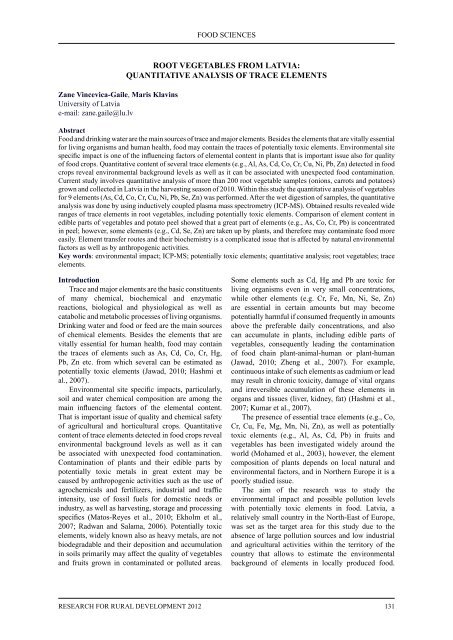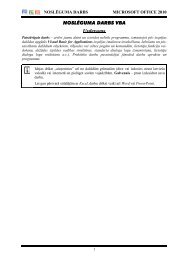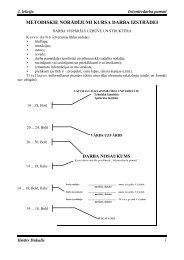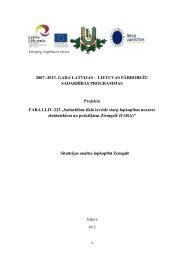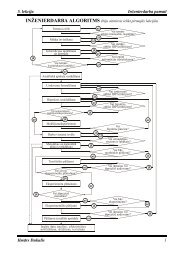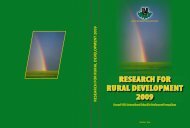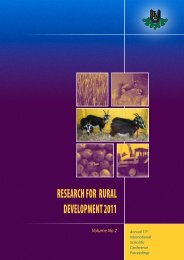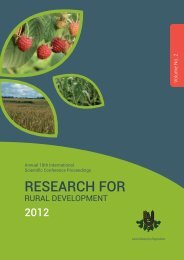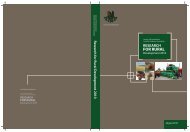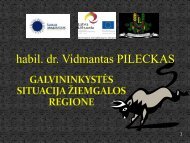LATVIA UNIVERSITY OF AGRICULTURE - Latvijas ...
LATVIA UNIVERSITY OF AGRICULTURE - Latvijas ...
LATVIA UNIVERSITY OF AGRICULTURE - Latvijas ...
- No tags were found...
You also want an ePaper? Increase the reach of your titles
YUMPU automatically turns print PDFs into web optimized ePapers that Google loves.
FOOD SCIENCESZane Vincevica-Gaile, Maris KlavinsUniversity of Latviae-mail: zane.gaile@lu.lvROOT VEGETABLES FROM <strong>LATVIA</strong>:QUANTITATIVE ANALYSIS <strong>OF</strong> TRACE ELEMENTSAbstractFood and drinking water are the main sources of trace and major elements. Besides the elements that are vitally essentialfor living organisms and human health, food may contain the traces of potentially toxic elements. Environmental sitespecific impact is one of the influencing factors of elemental content in plants that is important issue also for qualityof food crops. Quantitative content of several trace elements (e.g., Al, As, Cd, Co, Cr, Cu, Ni, Pb, Zn) detected in foodcrops reveal environmental background levels as well as it can be associated with unexpected food contamination.Current study involves quantitative analysis of more than 200 root vegetable samples (onions, carrots and potatoes)grown and collected in Latvia in the harvesting season of 2010. Within this study the quantitative analysis of vegetablesfor 9 elements (As, Cd, Co, Cr, Cu, Ni, Pb, Se, Zn) was performed. After the wet digestion of samples, the quantitativeanalysis was done by using inductively coupled plasma mass spectrometry (ICP-MS). Obtained results revealed wideranges of trace elements in root vegetables, including potentially toxic elements. Comparison of element content inedible parts of vegetables and potato peel showed that a great part of elements (e.g., As, Co, Cr, Pb) is concentratedin peel; however, some elements (e.g., Cd, Se, Zn) are taken up by plants, and therefore may contaminate food moreeasily. Element transfer routes and their biochemistry is a complicated issue that is affected by natural environmentalfactors as well as by anthropogenic activities.Key words: environmental impact; ICP-MS; potentially toxic elements; quantitative analysis; root vegetables; traceelements.IntroductionTrace and major elements are the basic constituentsof many chemical, biochemical and enzymaticreactions, biological and physiological as well ascatabolic and metabolic processes of living organisms.Drinking water and food or feed are the main sourcesof chemical elements. Besides the elements that arevitally essential for human health, food may containthe traces of elements such as As, Cd, Co, Cr, Hg,Pb, Zn etc. from which several can be estimated aspotentially toxic elements (Jawad, 2010; Hashmi etal., 2007).Environmental site specific impacts, particularly,soil and water chemical composition are among themain influencing factors of the elemental content.That is important issue of quality and chemical safetyof agricultural and horticultural crops. Quantitativecontent of trace elements detected in food crops revealenvironmental background levels as well as it canbe associated with unexpected food contamination.Contamination of plants and their edible parts bypotentially toxic metals in great extent may becaused by anthropogenic activities such as the use ofagrochemicals and fertilizers, industrial and trafficintensity, use of fossil fuels for domestic needs orindustry, as well as harvesting, storage and processingspecifics (Matos-Reyes et al., 2010; Ekholm et al.,2007; Radwan and Salama, 2006). Potentially toxicelements, widely known also as heavy metals, are notbiodegradable and their deposition and accumulationin soils primarily may affect the quality of vegetablesand fruits grown in contaminated or polluted areas.Some elements such as Cd, Hg and Pb are toxic forliving organisms even in very small concentrations,while other elements (e.g. Cr, Fe, Mn, Ni, Se, Zn)are essential in certain amounts but may becomepotentially harmful if consumed frequently in amountsabove the preferable daily concentrations, and alsocan accumulate in plants, including edible parts ofvegetables, consequently leading the contaminationof food chain plant-animal-human or plant-human(Jawad, 2010; Zheng et al., 2007). For example,continuous intake of such elements as cadmium or leadmay result in chronic toxicity, damage of vital organsand irreversible accumulation of these elements inorgans and tissues (liver, kidney, fat) (Hashmi et al.,2007; Kumar et al., 2007).The presence of essential trace elements (e.g., Co,Cr, Cu, Fe, Mg, Mn, Ni, Zn), as well as potentiallytoxic elements (e.g., Al, As, Cd, Pb) in fruits andvegetables has been investigated widely around theworld (Mohamed et al., 2003), however, the elementcomposition of plants depends on local natural andenvironmental factors, and in Northern Europe it is apoorly studied issue.The aim of the research was to study theenvironmental impact and possible pollution levelswith potentially toxic elements in food. Latvia, arelatively small country in the North-East of Europe,was set as the target area for this study due to theabsence of large pollution sources and low industrialand agricultural activities within the territory of thecountry that allows to estimate the environmentalbackground of elements in locally produced food.Research for Rural Development 2012131


